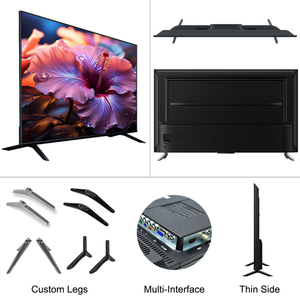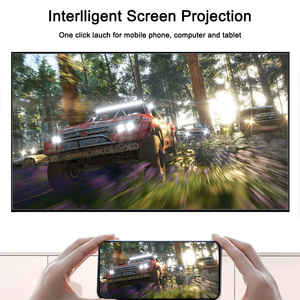(3183 products available)










































































































 Ready to Ship
Ready to Ship





















































































TV plasma screens are flat screen TVs that have been replaced by LCD and LED screens. Plasma screens use a series of cellsof neon and xenon gas-filled tubes that are between the pixels. When the gas is excited by an electric current, it produces ultraviolet light that excites phosphors, creating a pixel. The screens can create deep blacks and have a wide viewing angle. It has been discontinued, but here are some of its common types by resolution.
Standard Definition (SD)
These TVs have low resolution and picture quality. It is not as clear as modern flat-screen TVs. Generally, SD resolution is between 480 pixels horizontally and 480 pixels vertically. The screen size usually ranges between 36 inches and 50 inches, making them suitable for small to medium-sized living rooms and bedrooms. These TVs are best for watching regular cable television, older DVDs, and video games that are compatible with their resolution.
High Definition (HD)
These plasma screens have better picture quality and resolution than TVs with standard definition. The screen size is between 42 inches and 65 inches. The resolution is up to 1080 pixels, which is great for viewing cable news and sports, as well as modern HD-streaming services and Blu-ray discs. This size TV is suitable for medium-sized living rooms or bedrooms, and it can handle enhanced picture quality from HD sources like streaming services and Blu-ray discs.
Full HD (FHD)
These plasma screens offer a higher resolution than TVs with high definition. The resolution, which can reach 1080 pixels, provides clearer and sharper images. This screen size is suitable for large living rooms or home theaters because the screen size ranges from 50 inches to 65 inches or even larger. It works well for streaming videos and playing games that need high-resolution graphics. FHD TVs generally give users a much better viewing experience than HD TVs, especially on larger screens in big rooms.
Ultra HD (UHD) or 4K
These TVs give very nice pictures, showing details very clearly. They have a screen resolution of 4,096 x 2,160 to 4,096 x 2,178 pixels. A typical screen size is from 55 inches to over 80 inches. UHD is great for users who want the best quality pictures, especially on very large screens. Because their resolution is four times higher than FHD TVs, users can see much more detail in 4K videos and pictures. UHD works best with special 4K streaming services, as well as Blu-ray discs made for 4K.
The features and functionalities of a 50 inch plasma screen TV vary depending on the models available. However, some common features include the following:
The plasma TV has many applications in the consumer and commercial markets. It is used in many industries for entertainment and productivity purposes, which has contributed to its steady demand.
Home entertainment centers
Plasma screens deliver incredible pictures and have become traditional entertainment hubs in modern homes. They are typically used to watch television programs, streaming content, and view digital art. The large sizes are ideal for viewing sports, while mid-sized models can be used to show popular sitcoms and movies.
Exhibition centers
Plasma displays are used to produce attractive images in exhibition centers to attract and retain visitors. They are used to highlight product information, showing creative digital art and content. The crisp picture quality lures visitors and gets them to approach the displayed products and exhibits.
Businesses and offices
In conference rooms, plasma screens are used for scheduling meetings, making presentations, and brainstorming sessions. Their large sizes and crisp picture make it easy for participants to see and understand the displayed content. Some offices use plasma displays as digital dashboards to show real-time data about performance and productivity. The screens can also be used to display news and entertainment in break areas and lobbies.
Digital signage
Many retailers use plasma screens for digital signage to display promotions, advertisements, and branding. The vivid colors and crisp resolution attract the attention of potential customers and enhance brand visibility. Restaurants may display menus on plasma screens, which is better than the traditional printed menu. The screens can also show entertaining content while customers wait to be served.
Education and Training
In classrooms and lecture halls, plasma TVs show educational content, presentations, and interactive lessons. The large picture makes it easy for students to see and understand the content. Some classrooms also use plasma screens for entertainment during breaks. In corporate training programs, plasma displays can be used for refresher courses and employee onboarding. Traditional training methods require a lot of time and effort, but the interactive lessons on the plasma screen improve retention and comprehension.
Health facilities
In hospitals and clinics, plasma TVs provide entertainment for patients in waiting rooms and recovery areas. Patients can relax and enjoy programming while waiting for medical attention. Some health facilities also use plasma screens to show educational content about health topics and wellness.
Before buying a new plasma screen TV for sale, it is important to carefully consider the various factors influencing purchasing decisions. This will help buyers make better-informed decisions and invest in products that meet customers' needs.
Q1: What are the advantages of plasma TV screens?
A1: Plasma screens have a high contrast ratio and wide angle view, produce great pictures for large screen TV displays, and perform well for fast motion video.
Q2: Are there different types of plasma screens?
A2: Types of plasma screens include the standard and V screen, V screen with V rear, and the cut glass plasma with V screen, which has a protective layer of cut glass.
Q3: How does one clean and maintain a plasma screen TV?
A3: Use a slightly damp microfiber cloth to wipe off dust or light smudges from the screen. Avoid using paper towels, as they may scratch the display.
Q4: What type of support or service can be expected when buying a plasma screen from suppliers on Alibaba?
A4: Many suppliers offer different kinds of after-sales services and support. Buyers must check the specific terms and conditions for the service being offered and clarify any doubts before making a purchase.